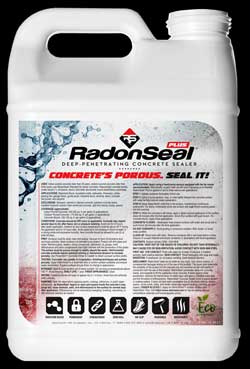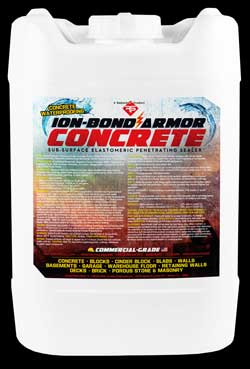How To Waterproof Your Concrete Blocks
Concrete blocks and cinder blocks are much more permeable to water and water vapor in comparison to poured concrete. According to ASHRAE Handbook, the permeability of concrete (1:2:4 mix) is 3.2 perms per inch of thickness. A high-quality, newly poured concrete wall (8-10 inches thick) has permeance (=permeability/thickness) of 0.4-0.3 perms (=3.2/8 – 3.2/10).
Heavyweight Concrete Blocks Are Semi-Permeable
Concrete blocks (CMUs) have larger pores than poured concrete and only thin walls (about 1-1/4-inch) next to their hollow cores (3.2/1.25 = 2.6 perms). Materials with a permeance of 1 to 10 perms are classified as “semi-permeable,” although the permeance of concrete blocks varies widely. Some tests show 4.8 perms for hollow concrete blocks and 2.4 perms when the blocks are filled with a slurry mix of concrete.
Block foundation walls will provide only a weak barrier against capillary water seepage and water vapor. Concrete blocks commonly begin to show signs of dampness or worse, leak water, soon after exterior waterproofing coatings deteriorate, crack, or fail. Cracks in the concrete blocks and mortar joints are exposed where water easily makes its way through. A tall water column builds up inside the hollow blocks and the hydrostatic pressure pushes water indoors, seeping through the pores and thin walls of the lower blocks. Over time and consistent exposure, water gradually leaches through the concrete pushing out efflorescence and enlarging the pores, making the blocks that much more porous.
Do you know the difference between cinder blocks and concrete blocks? Cinder blocks, lightweight CMUs, splitface blocks, haydite, and “popcorn blocks” are considered permeable to water and vapor (>10 perms) which makes waterproofing them even more difficult to seal!
DIY Waterproofing Solutions
STEP 1 – Water seeks the path of least resistance. Inspect the mortar joints for cracks, holes, separations, and anything that may be loose or beginning to crumble. Repoint the mortar joints if necessary.
STEP 2 – If the interior side of the concrete blocks routinely dampens, it is best to wait till the basement concrete block walls dry out before sealing against water penetration. Pick a time when there is less ground saturation due to extended periods of rain and snow melt. If the blocks are continuously wet, you can drain the water accumulated inside the hollow cores by drilling weeping holes in the bottom blocks (3/8″ masonry drill) and allow them to dry out for four or more days (the dryer the better).
STEP 3 – It is not unusual to see efflorescence or mold growth on damp concrete surfaces. If necessary, a light bloom of efflorescence can be removed using a wire brush. If the efflorescence is prevelant, use a combination of wire-brushing and apply our Efflorescence Cleaner. Applying a cleaner will efficiently remove the salt deposits from within the pores. For stubborn or heavier deposits, use a combination of wire-wheel drill attachment and the cleaner. If the efflorescence appears as a thick rocky buildup, aggressive mechanical means or harsh acids may be necessary.
Try to avoid using dangerous acids inside your home with the use of our easy, spray-on Efflorescence Cleaner. The cleaner will quickly dissolve the salts and kill mold and mildew growth.
Alternatively, you can use our BioZap All-Natural Mold & Mildew Cleaner instead of strong acidic cleaners or inhaling fumes from the use of chlorine bleach.
STEP 4 – Once the concrete is clean and thoroughly dry, apply RadonSeal Deep-Penetrating Concrete Sealer to the walls. RadonSeal works by being absorbed by porous concrete, reacting with lime and alkalis internally, and curing as a hardened mineral within the microscopic pores of the concrete. The concrete sealer will help to block water seepage and water vapor through the capillaries of the concrete. Unlike waterproofing paints or topical-clear coatings, RadonSeal withstands hydrostatic water pressure. It will not peel or be pushed out of the concrete.
STEP 5 – After the concrete surface has dried and RadonSeal has initially cured, plug the weeping holes with caulk, epoxy, or a concrete patching compound.
Tip – Good ventilation after the application or using a fan, dehumidifier, or heater will help, particularly in damp areas, to evaporate water from the sealer so that it can react and cure before the next big rain. If you are dealing with excessive groundwater due to heavy rains and snowmelt, it may be in your best interest to hold off sealing the concrete till drier weather returns.
When To Use the RadonSeal & Ion-Bond Armor Combination
Go the Distance! Combining Waterproofing Sealers
The combination of using RadonSeal Plus, followed by our Ion-Bond Armor Elastomeric Concrete Sealer, provides the tightest possible seal for concrete blocks and cinder block walls. Ion-Bond Armor is also a penetrating sealer that is applied 10+ days after RadonSeal has been used. The secondary sealer will chemically bond with RadonSeal, forming the strongest waterproofing seal within the matrix of the concrete.
Use the combination of both sealers for more challenging basement applications such as; cinder block foundation walls, concrete blocks that consistently seep water, leached-out blocks, thin concrete floors (less than 3″), and sandstone basement walls. We strongly recommend using both before framing walls during a basement remodeling project. The more you can do to block water from getting in, the better off you will be!
Not All Basements and Concrete Blocks Are The Same.
There is a possibility that applying RadonSeal Plus alone will suffice your waterproofing needs. However, not every situation is the same. Overly porous, leached-out blocks (due to years of continuous water seepage) may show improvement after using RadonSeal, but may still dampen after heavy rains and rising groundwater. If the thin walls of the block walls continue to show moisture, use Ion-Bond to further seal up the pores!
RadonSeal Plus + Ion-Bond Armor


Waterproofing Lightweight CMUs
Lightweight Split Face and Haydite Blocks
Split-face are Haydite blocks are dry-pressed blocks made with little or no cement (clay, shale, and slate). They are commonly used for above-grade construction as decorative blocks, building facades, retaining walls, garden boxes, and hardscapes.
Since RadonSeal relies on hydroxide produced as a result of the cement curing process, as the cement content decreases, the ability for RadonSeal to properly react also decreases. When sealing CMUs with low-cement content, the appropriate sealers of choice would be our LastiSeal Brick & Masonry Sealer or DryWay Water-Repellent Sealer.
They are chemically different, but both penetrating sealers share similar characteristics. Their nano-chemicals will be absorbed through the surface, plugging the pores to help waterproof the substrate against rainwater.
Summary – Prevention Pays Off
Prevention is Better Than Cure!
It is much easier for waterproofing sealers, paints, and membranes to work on blocks before, they start leaking! Long-term water seepage dissolves lime and salts, which shows up as efflorescence. Leaching enlarges the pores in the concrete and further speeds up the seepage, leaving hard-to-seal leached-out blocks.
